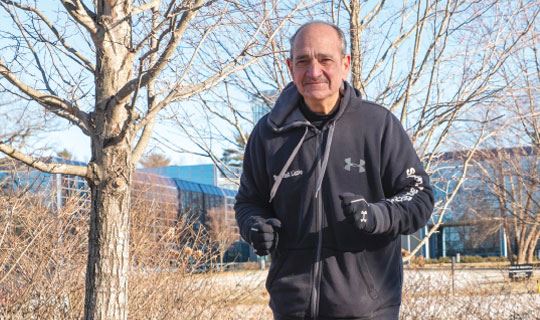“I’m stronger, faster and thinner than I’ve ever been in my life. I’ve never felt better.”

An Innovative Valve Replacement Surgery Allows a Man to Return to an Active Life
“I’m somewhat of a fitness advocate,” says Frank Lizzio, DC, 67, a chiropractor who practices in the Bronx. That’s an understatement. Frank became certified to teach spin cycling and group exercise classes at age 60. Prior to the COVID-19 pandemic, he was teaching six spin sessions and three or four group classes a week.
In the past two years, however, Frank has successfully faced unexpected cardiac challenges. “One cardiologist told me, ‘Thank God you’re in shape,’” Frank says. “It’s been quite a journey.”
That journey included traveling from his home in New York to Saint Barnabas Medical Center (SBMC) for a surgery known as transcatheter aortic valve replacement (TAVR) under the care of renowned surgeon Arash Salemi, MD, Clinical Chairman of Cardiothoracic Surgery for RWJBarnabas Health’s Northern Region and a member of RWJBarnabas Health Medical Group.
“As more and more patients are doing, he made the decision to cross the Hudson River and come to New Jersey for his care,” Dr. Salemi says.
An Unsettling Episode
One day in May 2019, Frank was at the gym when his left leg suddenly gave out. “I thought it was a cramp,” he says.
Unfortunately, the episode turned out to be a mild stroke. An echocardiogram taken at the time revealed that Frank also had a second major cardiac problem: severe aortic stenosis. The condition occurs when the valve leading to the aorta—the large blood vessel that carries blood from the heart to the rest of the body—becomes narrowed, straining the heart and eventually hindering the body’s blood supply. “I was told I needed to see a surgeon and get that valve changed,” Frank says.
As he researched his condition, Frank learned about TAVR. By June 2019, he was under the care of Dr. Salemi, an international leader in structural heart diseases, who has performed more than 2,000 TAVR procedures.
However, at the time TAVR had been approved only for use in high-risk patients too sick to undergo an open heart procedure. It wasn’t clear whether Frank would qualify.
Postponement Pays Off
After Frank went for a CT (computed tomography) scan in preparation for heart surgery, another challenge arose. “Dr. Salemi called and said, ‘I don’t know how to tell you this, but they found a stomach tumor,’” Frank says.
Heart surgery was postponed in order to perform urgent gastric surgery. “It was malignant cancer but fortunately was self-contained and hadn’t spread,” Frank says.
As it turned out, the delay was fortuitous: In the interim, the Food and Drug Administration approved TAVR for low-risk, relatively healthy patients like Frank.
“We now have a deep tool chest, and TAVR is essentially available to anyone with aortic stenosis, regardless of their relative risk,” Dr. Salemi says. “Open heart surgery is still an outstanding option for the appropriate person, but patient preference weighs heavily.”
“Naturally, I wanted the less invasive surgery,” Frank says. Dr. Salemi did the TAVR surgery in January 2020 at SBMC. “It was amazing,” Frank says. “I was in and out of surgery in an hour and a half, walking that afternoon and released the next day.”
Two weeks later, with catheter incisions healing nicely, Frank texted Dr. Salemi asking if he could start teaching spin classes again. “I thought he’d say, ‘What are you, nuts?’” Frank says. “But no, he said I could go for it—I just had to promise I’d go slower than normal.”
“I didn’t want him going gangbusters, but most patients have very few limitations imposed upon discharge,” Dr. Salemi says. “Frank was an extreme example of that and in some ways tested our limits, but he showed we can safely start pushing that valve even earlier than we thought.”
Frank says all his efforts have paid off. “I’m stronger, faster and thinner than I’ve ever been in my life,” he says. “I’ve never felt better.”
What is TAVR?
The aortic valve, one of four valves that regulate blood flow through the heart, opens so blood can flow out, then closes to ensure blood is only moving forward. With aortic stenosis, however, the aortic valve is narrowed and the heart has to work harder than it should to pump blood to the body.
That’s where heart valve replacement comes in. “For 60 years, valve replacement was done with an invasive, four-hour surgery,” explains Dr. Salemi. “We have perfected that technique, and we have great results with it. But transcatheter aortic valve replacement, known as TAVR, is a minimally invasive approach.”
With TAVR, a surgeon can approach the bloodstream through an artery in the leg. “We have a valve that’s crimped upon a catheter. We pass that valve through the bloodstream into the ‘doorframe,’ so to speak, of the patient’s aortic valve,” explains Dr. Salemi. “Once we have it positioned appropriately in that area, we inflate a balloon that expands a new valve in the place of the prior diseased valve.” The procedure takes an hour, and patients usually go home within 24 hours.
Patients at medical centers with a large volume of TAVR procedures, like Saint Barnabas Medical Center, typically have better outcomes and less chance of complication, according to a recent study by Dr. Salemi and his colleagues published by the American College of Cardiology.
“One of the major strengths of RWJBarnabas Health is our patient-centered care and attention to detail,” says Dr. Salemi. “There is a tremendous amount of expertise in our system, and we have assembled a multidisciplinary team comprised of cardiologists, interventional cardiologists, radiologists, anesthesiologists and cardiac surgeons who provide great results for our patients.”
To learn more about transcatheter aortic valve replacement at Saint Barnabas Medical Center, call 973-322-2200 or visit Transcatheter Aortic Valve Replacement.